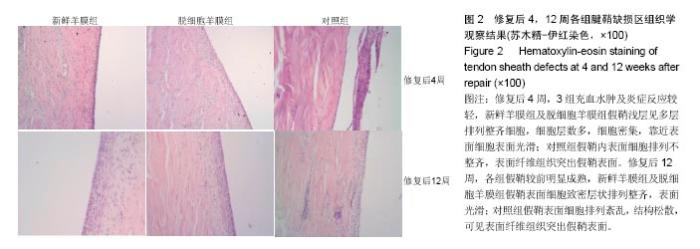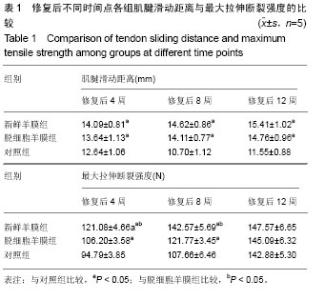| [1]Elkon O,Rank F.Experimental restoration of the digital synovial sheath. Scand J Plast Resconstr Surg.1997;11(3):213-218.[2]Lu H,Chen Q,Yang H,et al.Tanshinone IIA Prevent Tendon Adhesion in the Rat Achilles Tendon Model.J Biomater Tissue Eng.2016;6(9):739-744.[3]Tosun HB,Gumustas SA,Kom M,et al.The Effect of Sodium Hyaluronate plus Sodium Chondroitin Sulfate Solution on Peritendinous Adhesion and Tendon Healing.An Experimental Study.Balkan Med J.2016;33(3):258-266.[4]章庆国,白涛,冷永成.金箔预防屈肌腱粘连的实验研究[J].江苏医药,2001,27(2):218.[5]牟善霄,葛文学,成得元,等.大隐静脉修复鞘管防止肌腱粘连的实验研究[J].中华骨科杂志,1997,17(7):445-447.[6]张申申,王磊,郭卫中.大隐静脉包裹肌腱断端防止伸肌腱粘连的实验研究[J].实用手外科杂志,2015,29(1):71-73.[7]阎道海,石秀玲,刘前进,等.自体静脉移植重建腱鞘防止肌腱粘连[J].中国修复重建外科杂志,1997,11(1):38-39.[8]韩文冬,张强.自体脂肪颗粒纯化移植预防肌腱粘连的临床研究[J].实用骨科杂志,2006,12(6):509-511.[9]左强,章征源,张桦.带蒂筋膜脂肪瓣促进肌腱愈合防止肌腱粘连的实验研究[J].江西医学院学报,2006,46(2):37-40.[10]Jiang SC,Yan HD,Fan DP.Multi-layer electrospun membrane mimicking tendon sheath for prevention of tendon adhesions. Int J Mol Sci.2015;16(4):6932-6944.[11]薛辉,陈东,刘佳梅,等.去细胞肌肉组织工程支架与人羊膜上皮细胞的相容性研究[J].中国老年学杂志,2009,10(29):2598-2600.[12]徐梁,曹德君,刘伟,等.体内构建组织工程腱鞘的初步研究[J].组织工程与重建外科杂志,2008,4(6):308-311.[13]Baymurat AC,Ozturk AM,Yetkin H,et al.Bio-engineered synovial membrane to prevent tendon adhesions in rabbit flexor tendon model.J Biomed Mater Res A.2015;103(1):84-90.[14]Li LF,Zheng XY,Fan DP,et al.Release of celecoxib from a bi-layer biomimetic tendon sheath to prevent tissue adhesion. Mater Sci Eng C.2016;62:220-226.[15]Kesting MR,Loeffelbein DJ,Steinstraesser L,et al. Cryopreserved human amniotic membrane for soft tissue repair in rats.Ann Plast Surg.2008;60(6):684-691.[16]张振才,高文红,胡海涛,等.新鲜羊膜联合自体角膜缘干细胞、唇黏膜移植治疗重度眼睑球粘连[J].江苏医药,2009,35(9): 1078-1079.[17]Lee HN,Bernardo R,Han GY,et al.Human Amniotic Membrane Extracts have Anti-Inflammatory Effects on Damaged Human Corneal Epithelial Cells In Vitro.J Hard Tissue Biol. 2016; 25(3):282-287.[18]Shakeri S,Haghpanah A,Khezri A.Application of amniotic membrane as xenograft for urethroplasty in rabbit.Int Urol Nephrol.2009;41(4):895-901.[19]Dusko I,Ljiljana V,Milos N,et al.Human amniotic membrane grafts in therapy of chronic non-healing wounds.Br Med Bull.2016;117(1):59-67.[20]Meller D,Dabul V,Tseng SCG.Expansion of conjunctival epithelial progenitor cells on amniotic membrane.Exp Eye Res.2002;74(4):537-545.[21]董瑞一,赵红芳,田德虎,等.脱细胞羊膜对兔同种异体跟腱移植后粘连的预防作用[J].中华创伤骨科杂志,2013,15(6):509-513.[22]董瑞一,赵红芳,田德虎,等.羊膜包裹对兔同种异体跟腱移植愈合的影响[J].河北医药, 2013,35(14):2090-2092.[23]高鸣,赵红芳,田德虎,等.人羊膜修复腱鞘缺损的实验研究[J].中国修复重建外科杂志, 2013,27(5):335-339.[24]肖盼,陈剑.人羊膜问充质干细胞体外构建组织工程角膜上皮层的实验研究[J].中华实验眼科杂志,2015,33(11):991-995.[25]金瑛,李豫皖,张承昊,等.体外诱导人羊膜间充质干细胞向韧带细胞分化的实验研究[J].中国修复重建外科杂志, 2016,30(2): 237-244. |





